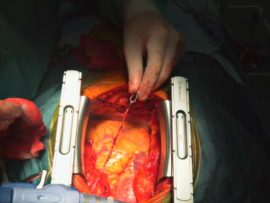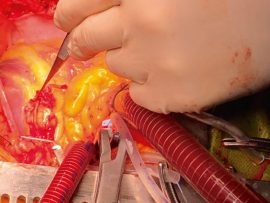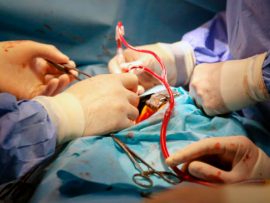Background Heparin resistance (HR) is often encountered during cardiovascular operations that require cardiopulmonary bypass. Clinical risk factors and the mechanism underlying heparin resistance are yet to be determined. The aim..
Lire la suiteAbstract Background There is still uncertainty about the safety of aprotinin for coronary artery bypass graft surgery. The ART (Arterial Revascularization Trial) was designed to compare survival after bilateral versus..
Lire la suiteAbstract Background When comparing effects of on- versus (CABG), it is important to assess the long-term clinical outcomes. However, most research conducted thus far has concentrated on short-term outcomes and ignored..
Lire la suiteAbstract Introduction: Residual pump blood from the cardiopulmonary bypass (CPB) circuit is often collected into an infusion bag (IB) and re-transfused. An alternative is to chase the residual blood into..
Lire la suitePulmonary hypoplasia is common in the perinatal period and a significant cause of death in newborn infants. Wigglesworth and Desai reported an incidence of 14.5% in a series of perinatal..
Lire la suiteAbstract Congenital diaphragmatic hernia (CDH) is typified morphologically by failure of diaphragmatic development with accompanying lung hypoplasia and persistent pulmonary hypertension of the newborn (PPHN). Patients who have labile physiology..
Lire la suiteAbstract Pediatric cardiovascular services are responding to the dynamic changes in the medical environment, including the business of medicine. The opportunity to advance our pediatric cardiology field through collaboration is..
Lire la suiteAbstract Introduction: Prophylactic intra-aortic balloon counterpulsation (pIABC) is recommended for high-risk patients undergoing coronary artery bypass grafting (CABG) surgery. Criteria for high-risk patients benefiting from pIABC are unclear. This study..
Lire la suiteAbstract Extracorporeal membrane oxygenation (ECMO) has been used increasingly for both respiratory and cardiac failure in adult patients. Indications for ECMO use in cardiac failure include severe refractory cardiogenic shock,..
Lire la suiteAbstract Vascular hyperpermeability is a frequent intractable feature involved in a wide range of diseases in the intensive care unit. The glycocalyx (GCX) seemingly plays a key role to control..
Lire la suiteObjective The aim was to evaluate the predictive value of for in adult cardiac surgery with . Design Retrospective and systematic review of the literature. Setting A tertiary university hospital. Participants 202 patients undergoing..
Lire la suiteSummary Anaemia is common before cardiac surgery and is associated with increased morbidity and mortality. The World Health Organization (WHO) definition of anaemia is lower for women than for men..
Lire la suiteAbstract Summary Development and standardization of fibrinolysis methods have progressed more slowly than coagulation testing and routine high‐throughput screening tests for fibrinolysis are still lacking. In laboratory research, a variety..
Lire la suiteBackground Various techniques have been employed for the early detection of perioperative cerebral ischaemia and hypoxia. Cerebral near‐infrared spectroscopy (NIRS) is increasingly used in this clinical scenario to monitor brain..
Lire la suiteAbstract OBJECTIVES To develop a model for predicting long-term survival following coronary artery bypass graft surgery. METHODS This study included 46 573 patients from the Australian and New Zealand Society of..
Lire la suiteAbstract The aim of this study was to evaluate the impact of blood transfusion on bloodstream infections. This study included 2764 patients who underwent isolated coronary artery bypass grafting. Blood..
Lire la suiteNeurological outcome and efficacy of intensive craniocervical screening for elective cardiac surgery
Abstract OBJECTIVES To evaluate the efficacy of intensive craniocervical screening before elective cardiovascular surgery. METHODS A retrospective analysis of 1134 consecutive patients who underwent routine screening before cardiovascular surgery between..
Lire la suiteBackground: Glutamine is the most abundant free amino acid in the body. It modulates immune cell function and is an important energy substrate for cells in critically ill patients. Reduction..
Lire la suiteThe Task Force for the Management of Valvular Heart Disease of the European Society of Cardiology (ESC) and the European Association for Cardio-Thoracic Surgery (EACTS)
Lire la suiteAbstract Summary von Willebrand factor (VWF) is a key player in hemostasis, acting as a carrier for factor VIII and capturing platelets at sites of vascular damage. To capture platelets, it..
Lire la suiteAbstract Background In children with congenital heart disease (CHD), altered pulmonary circulation compromises gas exchange. Moreover, pulmonary dysfunction is a complication of cardiac surgery with cardiopulmonary bypass (CPB). No data..
Lire la suiteAbstract Physiologically, blood ejected from the left ventricle in systole exhibited spiral flow characteristics. This spiral flow has been proven to have several advantages such as lateral reduction of directed..
Lire la suiteABSTRACT Background Early onset of lung injury is considerable common after cardiac surgery and is associated with increasing in morbidity and mortality, but current clinical predictors for the occurrence of..
Lire la suiteABSTRACT This study investigated the diagnostic value of urinary interleukin-18 (uIL-18) in acute kidney injury (AKI) after cardiopulmonary bypass (CPB) in clinical practice. A total of 103 patients who underwent..
Lire la suiteAbstract Prostacyclin (prostaglandin I2 [PGI2]) is an eicosanoid lipid mediator produced by the endothelial cells. It plays pivotal roles in vascular homeostasis by virtue of its potent vasodilatory and antithrombotic effects...
Lire la suiteAbstract Background: Several clinical trials have documented clinical benefits associated with prophylactic corticosteroid administration at the time of coronary artery bypass graft (CABG) surgery, including a reduction in the risk..
Lire la suiteAbstract Objective As with any biomarker, interpretation of changes of concentration must consider its variability in a specific clinical setting. The aim of this study was to calculate the reference change..
Lire la suiteAbstract Background Postoperative cognitive dysfunction (POCD) is a common complication of cardiac surgery. Studies have identified potentially injurious roles for cardiopulmonary bypass (CPB) and subsequent reperfusion injury. Cognitive dysfunction has..
Lire la suiteAbstract Objective We studied patients who had experienced a stroke in the postoperative period of cardiac surgery, aiming to analyse their progression and determine the factors that may influence prognosis..
Lire la suiteAbstract OBJECTIVES Organ protective management during aortic arch surgery comprises deep hypothermic (18°C) circulatory arrest (DHCA), or moderate hypothermia (28°C/ ‘tepid’) with regional cerebral perfusion (TRCP). The aim of this..
Lire la suite

















